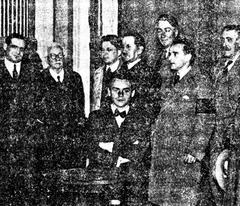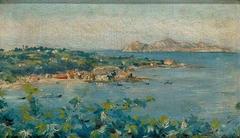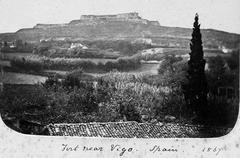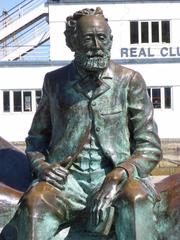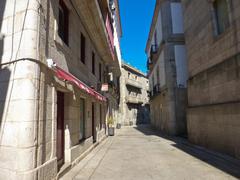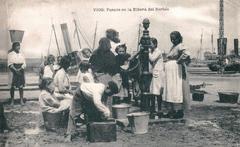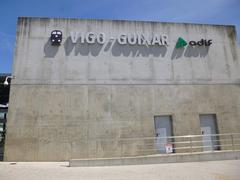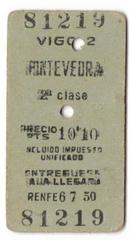Castro de Vigo: Visiting Hours, Tickets, and Guide to Vigo’s Premier Historical Site
Date: 04/07/2025
Introduction
Perched atop Monte do Castro and overlooking the vibrant city of Vigo, Castro de Vigo stands as one of Galicia’s most important archaeological and cultural treasures. This ancient fortified settlement, originating in the Iron Age, transports visitors back more than two millennia to the time of the Gallaeci people and the distinctive castro culture that shaped northwestern Iberia. Its strategic hilltop location not only provided defense and sweeping views of the Ría de Vigo estuary and the Atlantic but also positioned it as a focal point of local history, from prehistory through Romanization and into the modern era.
Castro de Vigo is more than a collection of ancient ruins—it is the heart of the city’s identity. With its reconstructed dwellings, panoramic viewpoints, and integration into lush urban parklands, it is a must-visit for history enthusiasts, families, and anyone seeking to understand the roots of Vigo. This guide brings together essential information on visiting hours, ticketing, accessibility, cultural context, and practical travel tips, ensuring you get the most from your visit (Concello de Vigo, Spotting History, Lonely Planet, Turismo de Vigo).
Contents
- Historical Overview
- Practical Visitor Information
- Things to See and Do
- Nearby Attractions
- Cultural Insights
- Frequently Asked Questions (FAQ)
- Summary and Final Tips
- References
Historical Overview
Origins and Archaeological Significance
Castro de Vigo traces its origins back to the Iron Age, between the 2nd and 3rd centuries BCE, though evidence of earlier human activity in the area—such as megalithic tombs and petroglyphs—suggests a much longer history (Vigo Archaeology). The settlement was a prominent castro, or fortified village, typical of the Celtic Gallaeci people who inhabited Galicia and northern Portugal before the Roman conquest.
Characterized by circular and oval stone dwellings, robust defensive walls, and an organized urban layout, Castro de Vigo was a thriving community engaged in agriculture, fishing, metalworking, and trade. The Roman conquest in the late 1st century BCE brought new influences, leading to a period of cultural fusion while the settlement maintained much of its indigenous identity (Spotting History).
The Castro Fortress and Later History
The strategic value of Monte do Castro endured well beyond the Iron Age. During the 17th century, the imposing Castro Fortress (Castelo do Castro) was constructed to defend the city from naval incursions, particularly during the Portuguese Restoration War. It later played roles in the Battle of Vigo Bay (1702) and the Peninsular War, cementing its place in local lore (Wikipedia: Castro Fortress). Today, the fortress and its gardens are integral parts of the site, offering both historical interest and recreation.
Practical Visitor Information
Location and Access
- Address: Paseo Cronista Xosé M. Álvarez Blázquez, 16, Freixeiro, 36203 Vigo, Pontevedra, Spain (official Vigo tourism website)
- Getting There:
- On Foot: 15–25 minutes from Vigo’s city center or the port; expect a moderately steep climb.
- By Bus: Several city lines stop near the base of Monte do Castro.
- By Car: Limited parking near the entrance.
- By Taxi: Readily available throughout Vigo.
Visiting Hours
- Castro de Vigo Archaeological Park: Daily, from early morning until dusk. Typical hours are 9:00 AM to 8:00 PM in summer (June–September) and 9:00 AM to 6:00 PM in other months. Confirm current hours before visiting (Turismo de Vigo).
- Castro Fortress: Same as above; open year-round.
Tickets
- General Admission: Free for both the archaeological site and fortress.
- Guided Tours: Offered in Spanish, Galician, and English; booking may be required and a small fee may apply.
Accessibility
- Main paths are paved, but terrain is steep and uneven in places.
- Wheelchair access is limited within the archaeological site and reconstructed dwellings.
- Assistance is available upon request.
Facilities
- Visitor Center: Information, maps, and tour bookings available.
- Restrooms: Located near the main entrance.
- Cafeteria: Café O’Castro serves drinks and light snacks.
- Picnic Areas: Benches and green spaces for relaxation.
- Pet Policy: Dogs allowed on a leash.
Things to See and Do
The Archaeological Site
- Ancient Celtic Ruins: Walk among reconstructed stone dwellings and original foundations, learning about daily life in Iron Age Galicia (Turismo de Vigo).
- Interpretive Panels: Multilingual signage provides historical context.
- Guided Tours: Available for deeper insights and archaeological context (Danas Vistas).
The Castro Fortress
- 17th-Century Fortification: Explore ramparts, towers, and courtyards that once defended the city (Wikipedia: Castro Fortress).
- Gardens and Fountains: Enjoy landscaped gardens and panoramic viewpoints.
- Cultural Events: Concerts, exhibitions, and festivals throughout the year (Visit Vigo).
Panoramic Viewpoints
- Miradoiro do Castro: Unmatched views of Vigo, the estuary, and Cíes Islands—ideal for photography at sunset.
Monuments
- Monumento ós Galeóns de Rande: Bronze sculpture commemorating the Battle of Rande (Travel Buddies).
Nearby Attractions
- Casco Vello (Old Town): Historic quarter with vibrant squares, seafood markets, and traditional Galician architecture (The Crazy Tourist).
- Museo Quiñones de León: Municipal museum displaying artifacts from Castro de Vigo (Museum Website).
- Beaches: Samil Beach and Playa del Vao, easily accessible by public transport or car.
- Cíes Islands: UNESCO-listed natural park accessible by ferry from Vigo’s port (Nomads Travel Guide).
Cultural Insights
Castro de Vigo is a powerful symbol of the city’s Celtic heritage and resilience. It is celebrated through festivals, music, and local legends, and plays a central role in events like the “Festa da Reconquista,” which honors Vigo’s resistance during the Peninsular War. The site’s preservation is a testament to the community’s commitment to historical continuity and cultural pride (Turismo de Vigo).
Frequently Asked Questions (FAQ)
Q: What are the opening hours of Castro de Vigo?
A: The site is generally open daily from 9:00 AM to 8:00 PM in summer and 9:00 AM to 6:00 PM in other months. Check the official tourism site for seasonal updates.
Q: Is there an admission fee?
A: Entry to the archaeological site and fortress is free. Guided tours may require booking and a small fee.
Q: Are guided tours available?
A: Yes, in Spanish, Galician, and English. Book ahead at the visitor center or online.
Q: How accessible is the site?
A: The main paths are paved but steep. Some areas are less accessible for wheelchairs or strollers.
Q: Are pets allowed?
A: Yes, dogs are welcome if kept on a leash.
Q: What are the highlights for families and children?
A: Wide open spaces, educational panels, and family-friendly events make it ideal for kids.
Summary and Final Tips
Castro de Vigo is a living monument to the city’s long history and vibrant cultural identity. Its archaeological significance, panoramic vistas, and integration with the urban landscape make it a highlight of any visit to Vigo. Whether you’re interested in ancient history, panoramic photography, or simply a peaceful stroll through lush gardens, Castro de Vigo has something to offer.
For the best experience:
- Visit in spring or autumn for mild weather and fewer crowds.
- Wear comfortable shoes for walking and climbing.
- Take advantage of guided tours for deeper insights.
- Don’t miss the sunset from the Miradoiro do Castro.
Stay informed about seasonal events and updates by checking the official Vigo tourism website before your visit.

